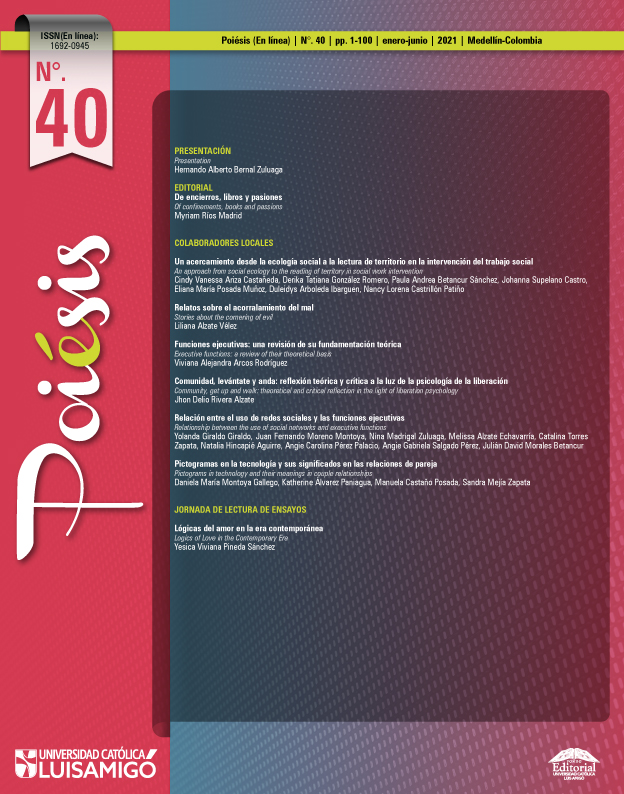Pictograms in technology and their meanings in couple relationships
DOI:
https://doi.org/10.21501/16920945.4055Keywords:
Symbolic language, Interpersonal relationships, Sign, Symbol, Bond.Abstract
This article reports on a research conducted in the city of Medellín during the second semester of 2019 and the first semester of 2020 with the objective of understanding the effects of images or pictograms (emojis) in current couple relationships. The research was qualitative of phenomenological cut; an in-depth interview was designed as an instrument for the collection of information and was applied to four informants who met the criteria for inclusion in the study. Among the findings is that love bonds are permeated by the rise of technology, since it is possible to consolidate them even in the physical absence of the other. In addition, pictograms acquire an important role in the communication of couples, in the expression of feelings and emotions, generating positive or negative subjective interpretations in some cases. The research allows us to conclude that communication in couple relationships has changed substantially nowadays, mutating to iconic forms, such as pictograms, a now pragmatic way to establish bonds, which allows the codification of love in virtuality.
Downloads
References
Álvarez González, F. J. (2018). El amor en los tiempos modernos. Repositorio digital de la Universidad Nacional de Educación. http://repositorio.unae.edu.ec/handle/56000/488
Bauman, Z. (2012). Amor líquido: acerca de la fragilidad de los vínculos humanos. Fondo de Cultura Económica.
Cornejo, M., y Tapia, M. L. (2011). Redes sociales y relaciones interpersonales en internet. Fundamentos en humanidades, 12(24), 219-229. http://fundamentos.unsl.edu.ar/pdf/articulo-24-219.
González-Miranda, E., y Quindós-González, T. (2015). Diseño de iconos y pictogramas. Campgràfic Editors.
Hertlein, K. M., y Blumer, M. L. (2014). The couple and family technology framework: Intimate relationships in a digital age. Routledge.
Fuster Guillen, D. E. (2019). Investigación cualitativa: Método fenomenológico hermenéutico. Propósitos y representaciones. Revista de Psicología Educativa, 7(1), 201-215. DOI: 10.20511/
pyr2019.v7n1.267
Leggett, C., y Rossouw, P. J. (2014). The impact of technology use on couple relationships: A neuropsychological perspective. International Journal of Neuropsychotherapy, 2(1), 44-99. DOI: 10.12744/ijnpt.2014.0044-0099
Mazzei, B. J. (2018). La influencia de la comunicación virtual en la relación de pareja [Trabajo de grado, Universidad Católica Argentina]. https://repositorio.uca.edu.ar/bitstream/123456789/8417/1/
influencia-comunicacion-virtual-mazzei.pdf
McDaniel, B. T., y Coyne, S. M. (2016). “Technoference”: The interference of technology in couple relationships and implications for women’s personal and relational well-being. Psychology of
Popular Media Culture, 5(1), 85-98. DOI: 10.1037/ppm0000065.
Morozov, E. (2015). La locura del solucionismo tecnológico. Clave intelectual y Katz Editores.
Picardo Joao, O., Escobar Baños, J. C., y Pacheco Cardoza, R. V. (2005). Diccionario Enciclopédico de Ciencias de la Educación (1.ª ed.). Centro de Investigación Educativa, Colegio García Flamenco. https://online.upaep.mx/campusvirtual/ebooks/diccionario.pdf
Rodríguez Martín, L. I. (2011). “Siempre estamos conectados: así sé que me quiere mucho”. Comunicaciones en familias transnacionales a través de internet. Revista Latinoamericana de Estudios de Familia, (3), 50-64. http://biblioteca.clacso.edu.ar/gsdl/collect/co/co-035/index/assoc/D14048.dir/RLEF3_Completa.pdf#page=51
Taylor, S. J., y Bogdan, R. (1987). Introducción a los métodos cualitativos de investigación. La
búsqueda de significados. (1.ª ed.). Paidós.
Watzlawick, P., Beavin Bavelas, J., y Jackson, D. D. (1991). Teoría de la comunicación humana:
interacciones, patologías y paradojas. Herder.
Zúñiga Escobar, N. L. (2018). ¿Bien y tú? Construcción del vínculo afectivo de pareja con la intermediación
de las aplicaciones virtuales Instagram y WhatsApp: el caso de seis jóvenes del eje
conurbano Cali–Jamundí. [Universidad de San Buenaventura]. http://bibliotecavirtualoducal.
uc.cl/vufind/Record/oai:localhost:10819-5685
Published
How to Cite
Issue
Section
License
Copyright (c) 2021 Poiésis

This work is licensed under a Creative Commons Attribution-NonCommercial-NoDerivatives 4.0 International License.
La revista y los textos individuales que en esta se divulgan están protegidos por las leyes de copyright y por los términos y condiciones de la Licencia Creative Commons Atribución-No Comercial- 4.0 Internacional. Permisos que vayan más allá de lo cubierto por esta licencia pueden encontrarse en http://www.funlam.edu.co/modules/fondoeditorial/ Derechos de autor.











